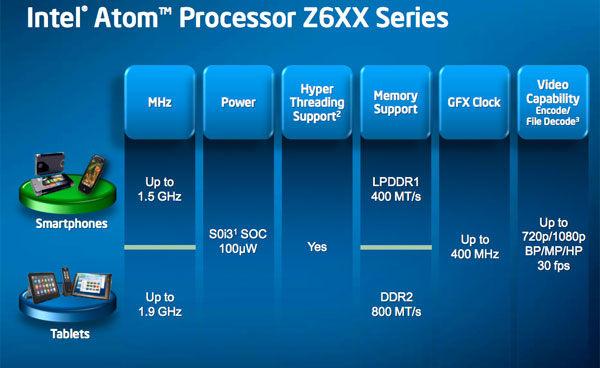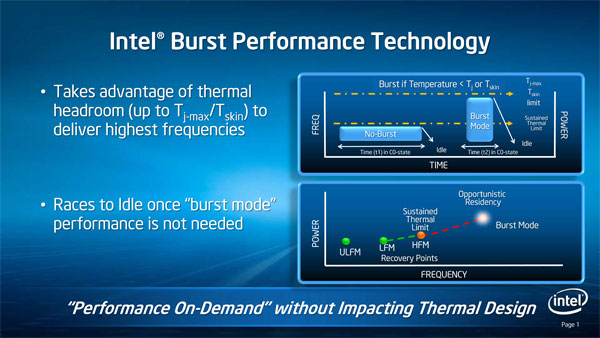Intel Unveils Moorestown and the Atom Z600, The Fastest Smartphone Platform?
by Anand Lal Shimpi on May 4, 2010 11:54 PM EST- Posted in
- Smartphones
- Intel
- Atom
- Mobile
- SoCs
Clock Speeds: 1.2GHz - 1.5GHz for Smartphones, 1.9GHz for Tablets
Intel isn't announcing individual Atom Z600 SKUs just yet, but we do know that all versions of the chip will support Hyper Threading (likely due to maintain a performance advantage compared to upcoming dual-core ARM offerings). There will be two versions of the Atom Z600 chips, one for smartphones and one for tablets.

The smartphone SKUs will run between 1.2GHz and 1.5GHz, while the tablet version of the Z600 will run at up to 1.9GHz.
Power Management: Clock Down or Turbo Up
Eleven years ago Intel demoed a technology it called Geyserville for mobile CPUs. The technology simply ran the CPU at a lower frequency when running on battery power and a higher frequency when plugged in. Intel eventually called this SpeedStep.
Four years later we got EIST, Enhanced Intel SpeedStep Technology. This allowed a mobile (and eventually desktop) CPU to run at any frequency depending on the performance demanded by the OS and the running applications.
On today’s Atom processors this usually means the chip will run as low as 600MHz when idle and at 133MHz increments all the way up to 1.66GHz under load. You don’t normally drop below 600MHz because that falls into the inefficient range of CPU performance scaling for a netbook/nettop. In a smartphone though, the majority of time your CPU isn’t being used. The SoC and accessory processors have enough custom logic offload a lot, even when your phone isn’t idle.
Lincroft, or the Atom Z600 series, supports even lower frequency modes. The CPU can clock itself down well below 600MHz.
When you need performance however Lincroft has something similar to Turbo Boost on Intel’s desktop CPUs. On the Atom Z600 series it’s called Burst Mode and unlike Turbo, it is more tightly integrated with the OS.

EIST and other dynamic clocking technologies rely on OS P-states to determine what frequency the chip should run at. If an OS requests P0, the CPU simply runs at its highest frequency.
On the Core i5 and i7, if the OS requests the CPU be in P0, then as long as the chip doesn’t violate any current or TDP limitations it will run at a higher turbo frequency instead of the default maximum clock speed the OS is requesting. P0 will always return the highest possible frequency given the thermal conditions of the chip.
The Atom Z600 doesn’t work like this. All potential burst mode frequencies are enumerated as P-states by the BIOS. An OS with proper support for Moorestown will be able to request any specific clock frequency, even burst frequencies. Loading a web page for example might result in the OS asking for the highest possible burst mode frequency, but while you’re reading the page the OS might request a slower P-state. The chip will run at whatever the OS requests, but it will exit burst mode if the chip’s temperature gets too high.
The FSB speed also scales with clock frequency. Once you reach a certain clock speed threshold, the Atom Z600 will automatically double its FSB frequency to help feed the CPU faster. The goal isn’t just to deliver peak performance, but it’s also to complete tasks faster so that the SoC can return to an idle state as soon as possible. The hurry up and go idle approach to mobile CPU performance has been one of Intel’s basic tenants for well over a decade now. And it does work. This is the reason we’ve generally seen an increase in battery life from each subsequent version of the Centrino platform.
The software management of burst mode puts more emphasis on the OS and platform vendors to properly tune their devices for the best balance of performance/power consumption. You can see why Wind River’s Android platform and Moblin are necessary to get the most out of Moorestown.










67 Comments
View All Comments
Mike1111 - Wednesday, May 5, 2010 - link
IMHO Anand meant app-centric smartphones, David Pogue calls them app phones.jasperjones - Wednesday, May 5, 2010 - link
i don't see how recent symbian devices are not "app centric." you have the publicly available sdk, the ovi store, etc.BrooksT - Wednesday, May 5, 2010 - link
So your argument is that symbian is a bigger player in the app phone market than Apple because their *latest* phones support apps?The "smartphone" / "app phone" semantic difference is annoying, but if we look at, say, number of applications available or downloaded, Symbian and RIM are distant third and fourth places. Likewise with app usage, even just internet browsing.
If you want to talk about smartphones as they existed in 2006, then yes, both Symbian and RIM are much bigger than Apple or Android.
jasperjones - Wednesday, May 5, 2010 - link
To clarify: I said "recent" because the first Symbian smartphones came out almost 10 years ago--of course, those weren't app-centric.My original comment on Anand's article still stands. I'm talking about IDC's and Canalys' reports on 2010:Q1 smartphone sales which became available just days ago. Of course, most of the smartphones sold by Nokia and RIM in the first quarter allow for installation of apps such as Facebook, Ovi Maps, etc., etc.
WaltFrench - Sunday, May 9, 2010 - link
“…Apple and Google dominate the smartphone market. This is utter nonsense.”All you have to do is to look at the developer space. How many app developers are creating apps for the unreleased RIM OS 6? … for the Symbian OS^3, due out in “select” markets sometime in Q3?
If older apps work OK in these new OS incarnations, and if Blackberry and Nokia users are heavy app downloaders (or for some reason will become heavy users), then the current sales-share leaders are relevant, but still not dominant, in the future of app phones.
nafhan - Wednesday, May 5, 2010 - link
I'm curious about the PCI bus requirement for Windows 7 that would prevent it from running on Moorestown devices. Does it have something to do with storage, maybe? I'm having trouble finding specifics online as well. If someone could enlighten me, it would be appreciated.DanNeely - Wednesday, May 5, 2010 - link
This is almost certainly a factor of windows being a monolithic kernel and MS not having any way to say "this PC doesn't do PCI". This is something that MS will have to deal with in the medium term future anyway. PCI slots are going away from some high end mobos; it's only a matter of time before they disappear from mainstream boards and stop being used to attach misc controllers like PATA (slowly going away entirely) or FireWire (FW3200 will need PCIe bandwidth). At that point intel will want to take it out of their chipsets as a cost saving feature, and oems will not be happy if they have to install a PCIe to PCI bridge to maintain windows compatibility.Drizzt321 - Wednesday, May 5, 2010 - link
Maybe HP/Palm should get with Intel and optimize WebOS for this. Much of the WebOS stack is just Linux, Webkit, plus other F/OSS stuff like gstreamer and the like so I wouldn't be surprised if it isn't as big an effort as, say, Symbian or anything like that.This could be a big break for Intel and HP/Palm, since HP/Palm needs something big to help it move on to the next WebOS device, and the OS could certainly see some benefits to more CPU power. I've heard the overclocking patches raising the CPU to 800MHz can really help things.
sleepeeg3 - Wednesday, May 5, 2010 - link
Please stop designing faster phones.Phone A lasts 24 hours standby
Phone B lasts 6 hours standby
After 6 hours, Phone B's battery is dead. How much use do you get out of a phone with a dead battery? 0.
999GHz x 0 is still... 0!
This push toward faster phones, without even considering battery life, is nuts. Phones are impractical tools for just about everything, but calling, messaging and photographs. None of these are CPU intensive. Dependability is more important than how fast the dial screen opens.
Moorestown may include better power architecture, but it throws this away by jacking up the processor speed.
Lets get back to practicality and make phones functional again. This push toward cutesy 1000mAH/1GHz+ phones that die in a few hours is moronic.
Is it too much to ask for phones that last a week?
metafor - Thursday, May 6, 2010 - link
There are plenty of phones that last a week...They even cost significantly less than GHz smartphones and usually don't come with a 2-year contract.
But they don't have giant 4.2" AMOLED screens (which btw, is ~50% of the power consumption) either.